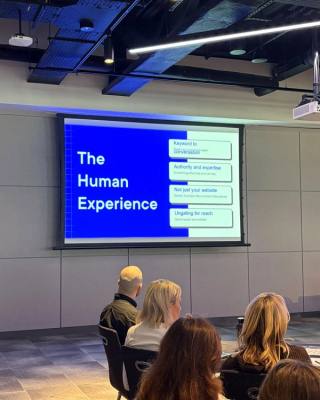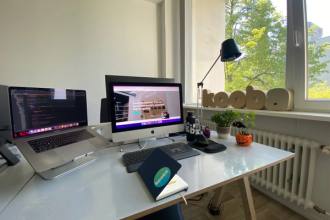We would never pretend otherwise: what a site looks like matters an awful lot. And we take time to ensure we get it right. No client is going to sign off on something that looks like a dog’s dinner after all.
But beyond aesthetics, web design plays an absolutely vital role in lead generation. And that, ultimately, is what our job is about. Converting visitors into leads, and driving the metrics that really matter to most of our clients.
A well-designed website prioritises user experience (UX), and provides easy navigation and intuitive interfaces that guide visitors towards desired actions (what we want them to do, in more straightforward language). In the same spirit, clear and compelling calls to action should help to get them there, and great landing pages and forms need to finish the job.
In this blog post I want to discuss all of these in turn, but first, it might be worth considering precisely why a website is important to the broader goal of lead generation.
Why websites matter
Most CMOs or Marketing Directors would agree: a good website is a website that maximises lead gen. Or at least that is what they would say out loud.
But that isn’t the whole story. If you asked them the relative importance of a website when it comes to overall lead numbers, you might hear that it matters, but not so much.
We disagree. In almost all cases, your website is absolutely vital to your lead-generation efforts. Here’s why.
In a huge number of cases, when any one of your potential customers:
- Hears your brand mentioned
- Is called or emailed by one of your outbound sales team
- Sees an advert for your brand (or even clicks on it!), or
- Sees your brand in any other context
There’s a high probability the first thing they will do is visit your website. The truth is, even in these days of off-site lead generation, almost everything still goes through your site, and how your site converts matters.
I don’t want to labour the point, but if you need a little more convincing read this post we wrote some years ago which sums up the arguments around landing pages specifically, but which applies to everything you do online.
And now that’s done, let’s discuss how to build sites that really convert.
Getting UX right
The importance of UX when it comes to effective lead generation cannot be overstated. To put it simply: a well-designed website with intuitive navigation and a visually appealing layout makes it easier for visitors to find the information they need, for them to take the actions you want them to, and (often forgotten) just gives them a good impression of your business.
It doesn’t end there. Good UX boosts trust and credibility (even if the person on the other side isn’t aware of this), increasing the likelihood that visitors will willingly provide their contact information or engage in a conversion process. The goal is always to remove friction. To let users find what they want, to gently guide them towards desired outcomes, and to get out of the way.
To do this effectively means to think carefully about who is using your site, what their expectations are, and what approaches you can take to meet those. It means adopting user-centred design methodologies and ensuring that the criteria used to measure success are less “does it look nice?” and more “is it working?”
This probably isn’t the time or place to get into detail around information architecture and site navigation, and indeed it is not a subject that suits ‘one size fits all’ pronouncements anyway (but if you are interested in reading more, try our article here). The approach is what counts - thinking about how the user experience is influencing the lead generation process at every step of the way, and designing accordingly.
CTAs
Calls to action (CTAs) are one of the more misunderstood aspects of web design, so let's get the big misconception out of the way first: more is not always better. You are not going to see a sudden leap in conversion and lead generation if you have hovering CTAs plastered all over your page at every turn (anyone else remember those days?)
Instead, think clearly about what you want the user to do at any given point in time. By the same token, think about what the user themselves might want to do. A well-placed CTA is one that encourages the user to take action at just the right time, and is relevant to the current context of the site.
To give a quick example, “View a demo” as a CTA is often going to work in sections of the site that discuss the product in detail. It is a natural next step for a user who wants to understand precisely what is under the hood. In the same way, after every piece of content (in whatever form) you should be asking yourself ‘what happens next?’ - and ensuring that it can.
Of course, there is a lot more to be said on the subject, and yes, you should always have a way to contact your business on screen, but for now let’s move on to where those CTAs take us: the landing page.
Landing pages
A well-optimised landing page is crucial for lead generation. In fact, your most popular landing pages are almost certainly the most important real estate your company has. Think of all the effort and money you spend getting people to this point. Only to lose an uncomfortable number of them, who you may never see again.
So if you learn nothing else from this piece, please remember to give landing pages the love and focus they deserve. Everything goes through them!
Focus is key. Streamlined and focused landing pages, with minimal distractions, enable visitors to quickly understand the value proposition and take the desired action. Keep your forms simple and clear, and ask for the information you need, not every single thing that you want (you can read more about form design here).
At the same time, do give the user enough to make a decision. Incorporating ‘trust signals’ instills confidence in visitors. That can mean customer testimonials, case studies, security badges and social proof indicators, all of which help to establish credibility and reduce any last-minute doubts your visitors might be having.
Even here, don’t neglect the power of good visual design. If you need people to scroll down, make sure to lead the eye in that direction. Don’t simply have one horizontal pane after another, for example.
Wrapping it all up
In a sense, optimising websites for lead generation is at the heart of everything we do at Kooba. And as a result, it is almost impossible to summarise, or even scratch the surface, of everything we would want to cover in a post like this. Ultimately the lesson is a simple one: think of your site as a central element (in many ways the most important element) in your lead generation strategy, and make your design decisions accordingly.
But just make sure it looks good too.









